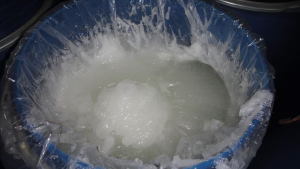
Sodium Lauryl Ether Sulfate SLES

Specifications
| Item | Index |
| Appearance | White to yellowish viscous paste |
| Active Matter %≥ | 70±2 |
| Sodium Sulfate %≤ | 1.5 |
| Unsulphated matter %≤ | 3.5 |
| Color (Hazen 5% a.m.)≤ | 20 |
Packing & Storage
| Packing | in 170kg Drum or 1050kg IBC |
| Storage | 20℃, 2 years. |
| Shipping | Room temperature in China; may vary elsewhere |
Free Quote
At present, the company has more than 10 experienced export sales .
For samples, pricing, or more information, please call us at 0086-25-52397805 or mail to info@ascent-chem.com or we will respond to you as soon as possible.
Tel: 0086-25-52397805
E-mail: info@ascent-chem.com

General Information
| Common Names | Sodium Lauryl Ether Sulphate | Lauryl ether sulfate sodium | (C10-C16) Alcohol ethoxylate sulfated sodium salt | ||||||
| Structure | |||||||
| CAS No. | 9004-82-4, 68585-34-2 | Boiling Point (℃) | N/A | ||||
| Molecular Weight | 362.5009 | Melting Point (℃) | N/A | ||||
| Appearance | White to yellowish viscous paste | Vapor Specific Gravity | N/A | ||||
| HS Code | 3402390000 | Flash Point (℃) | N/A | ||||
| Solubility | N/A | Autoignition Temperature (℃) | N/A | ||||
| Safety Phrases | |||
| RIDADR | |||
| WGK Germany | |||
| Packaging Group | |||
| Hazard Class | |||
| SYMPTOMS | PREVENTION | FIRST AID | |
| Inhalation | Cough. Sore throat. | Use local exhaust or breathing protection. | Fresh air, rest. |
| Skin | Redness. Burning sensation. Itching. | Protective gloves. | Remove contaminated clothes. Rinse and then wash skin with water and soap. |
| Eyes | Redness. Pain. | Wear safety goggles. | First rinse with plenty of water for several minutes (remove contact lenses if easily possible), then refer for medical attention. |
| Ingestion | Abdominal pain. Nausea. Vomiting. | Do not eat, drink, or smoke during work. Wash hands before eating. | Rinse mouth. Induce vomiting (ONLY IN CONSCIOUS PERSONS!). Refer for medical attention . |
Put 452 kg of lauryl alcohol (hydroxyl value 275-320) into the reactor and 5kg of potassium hydroxide into the mixing tank to prepare a 50% aqueous solution and put it into the reactor. Vacuum is pumped, the vacuum degree is controlled at 13.3kPa, and the temperature is gradually raised to about 120℃ for dehydration. After dehydration, nitrogen was used to replace the air. After the air was driven out, the temperature was raised to 140 ~ 150℃. After stirring, 324kg ethylene oxide was injected at 3 kPa. Then gradually reduce the kettle temperature to about 5℃. Sulfuric acid was added for acidification reaction, and after 1h, caustic soda and alcohol solution were used for neutralization. After neutralization, pressure filtration removes the filter residue, and the filtrate dealcoholizes to produce the finished product.
Frequently Asked Questions
Performance and application of sodium lauryl ether sulfate SLES
Sodium Lauryl Ether Sulfate (SLES) is a surfactant and detergent ingredient commonly used in various personal care and household cleaning products. It is derived from natural sources, primarily coconut oil, through a process called ethoxylation.
SLES is known for its ability to create lather and foam, making it a popular ingredient in products such as shampoos, soaps, shower gels, toothpaste, and detergents. It helps to cleanse and remove dirt, oils, and other impurities from the skin and hair.
Here are some key characteristics and properties of SLES:
1. Surfactant: SLES is an effective surfactant, which means it can lower the surface tension of water, allowing it to spread more easily and interact with oils and other substances.
2. Foaming Agent: SLES produces rich, stable foam when mixed with water, making it desirable in products that require lathering and foaming properties.
3. Emulsifier: SLES has emulsifying properties, which means it can help mix and stabilize oil and water-based ingredients in a formulation, preventing them from separating.
4. Cleaning Power: SLES has excellent cleansing abilities, enabling it to remove dirt, oils, and greasy residues effectively.
5. Compatibility: SLES is compatible with a wide range of other ingredients commonly used in personal care and cleaning products, making it suitable for various formulations.
However, it’s worth noting that SLES can be a potential skin irritant for some individuals, especially those with sensitive skin. It can cause dryness, redness, and itching in some cases. Some people also express concerns about its potential environmental impact due to its production process and biodegradability.
In recent years, there has been an increasing trend towards using alternative surfactants in personal care products that are perceived as milder and more environmentally friendly. As a result, some brands have started to replace or reduce the use of SLES in their formulations, opting for alternatives like Sodium Lauryl Sulfate (SLS), which is derived from petroleum.

